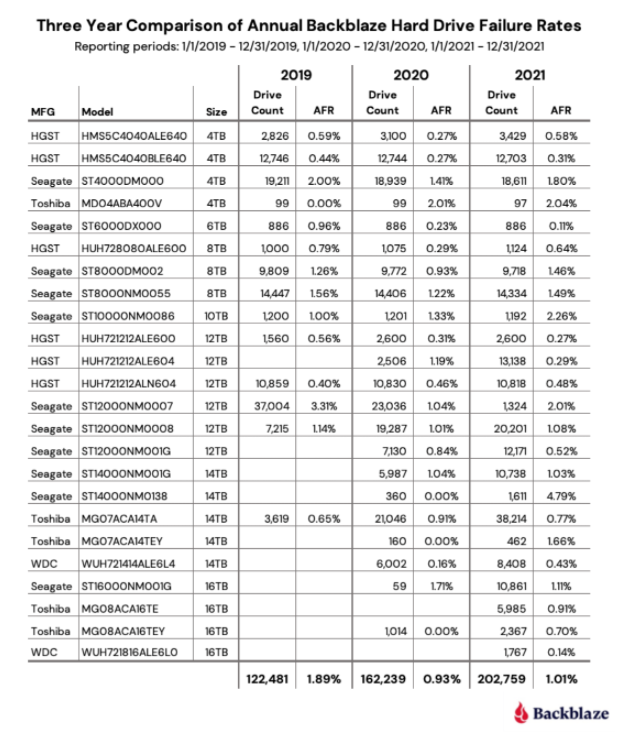Seagate HDDs Top and Bottom Backblaze’s 2021 Failure Rates Data
HDD failure rates remain low overall.
From the rise and fall of Chia coin to console-oriented SSDs, 2021 was an unusual year for storage. We’ve been keeping track of the best SSDs and best HDDs, but Backblaze, a cloud storage service publishes quarterly and annual drive stability reports about its whole suite of drive options. The company’s most recent report focused on its HDD stable.
Let’s preface this: we weren’t involved in gathering any of this data, and you should take Backblaze’s results with the same grain of salt you should apply to data from any corporate source. They are trying to sell you a service, after all. Nonetheless, Backblaze’s reports have historically been a great place to start looking for larger trends in storage reliability, and the company’s had no qualms about reporting drive failures before. This data isn’t, at least, coming straight from Seagate or Toshiba.
In 2021, Backblaze added 40,640 drives to its stable, adding up to a total of 206,928 drives under its management. The vast majority of those drives are data drives, aka hard drives, although 3,760 are boot drives, aka SSDs. Again, this Backblaze report focuses on data drives, so those are what we’ll be talking about here as well. For SSDs, you’ll have to wait for a new report that will come out in “the next few weeks.”
Further, the company removed 409 drives from its data collection this year as they were either used for experimental testing or had a sample size of less than 60 each. This leaves the report with data from 202,759 drives over all.
Of those drives, there are models from Seagate, Toshiba, WDC and HGST. Across the year, the model with the lowest failure rate (0.11%) was the 6TB Seagate, which is impressive given that this model is also the oldest in Backblaze’s fleet (boasting an average age of 80.4 months). Conversely, the model with the highest failure rate (4.79%) was also a Seagate, specifically the company’s 14TB model. According to Backblaze, this drive was failing at a higher than expected rate, and units are currently undergoing analysis and firmware upgrades that helped see failure rates drop slightly in between Q3 2021 (6.29%) and Q4 2021 (4.66%).
While this means Seagate largely isn’t seeing a crippling blow to its reputation, those numbers go to show the importance of researching specific drives rather than relying on company reputation when buying, although a 14TB capacity is beyond what most individual consumers will be looking for. Among 4TB drives, the lowest capacity in Backblaze’s data fleet, the model with the least amount of failures was one of two offerings from HGST (model HMS5C4040BLE640). Meanwhile, the manufacturer with the least amount of failures was WDC.
Before we move on, it’s important to address how Backblaze counts failure rates. Its data sheets refer to these with a term called “AFR,” which stands for “annualized failure rate.” This is slightly different from “annual failure rate,” in that it adjusts the data to account for drives which were added to or removed from the fleet partway through the year. This, overall, provides a more accurate picture, making sure that new, unfailing drives added in Q4 don’t make a model look more reliable than it otherwise might have. Regardless, if you’re curious, the formula for calculating AFR is as follows: AFR = (drive failures / (drive days/365)) * 100.
Get Tom's Hardware's best news and in-depth reviews, straight to your inbox.
While Backblaze’s oldest drive was also its most stable, the company’s data also suggests that newer drives are holding up well. Specifically, the 16TB WDC drive collection it added this year has only been in the fleet for an average of 5.06 months but has a low AFR of 0.14%. Similarly, its 16TB Toshiba additions are also off to a strong start.
What does this all mean for hard drive storage in 2021 overall?
Overall, failure rates were low, with an average AFR of 1.01% across all drives, although smaller drives (those below 12TB) made up the majority of issues. That could point to problems for the average consumer, who is less likely to need a drive above 12TB in capacity, but it’s also worth pointing out that Backblaze’s larger drives were also newer. For specific numbers, Backblaze says that large drives “total[ed] 66% of the drive days total, while only producing 57% of the drive failures.”
Supply also remained unhampered by the boom of Chia coin this year, continuing a trend from Backblaze’s Q2 2021 data. Overall, Backblaze retired no drives this year and added two drive models to its fleet. The percentage of Toshiba drives in its fleet has also increased over the year, although that points less to faith in Toshiba drives specifically and more to a desire to diversify the fleet for greater flexibility.
Hard drives are an aging form of storage, although they’re still great for getting cheap access to large capacities of data, and because they involve moving parts, it’s important to pay attention to failure rates when in the market for one. Stay tuned for SSD results, and you can visit Backblaze’s site for a complete picture of its HDD data.
Michelle Ehrhardt is an editor at Tom's Hardware. She's been following tech since her family got a Gateway running Windows 95, and is now on her third custom-built system. Her work has been published in publications like Paste, The Atlantic, and Kill Screen, just to name a few. She also holds a master's degree in game design from NYU.



